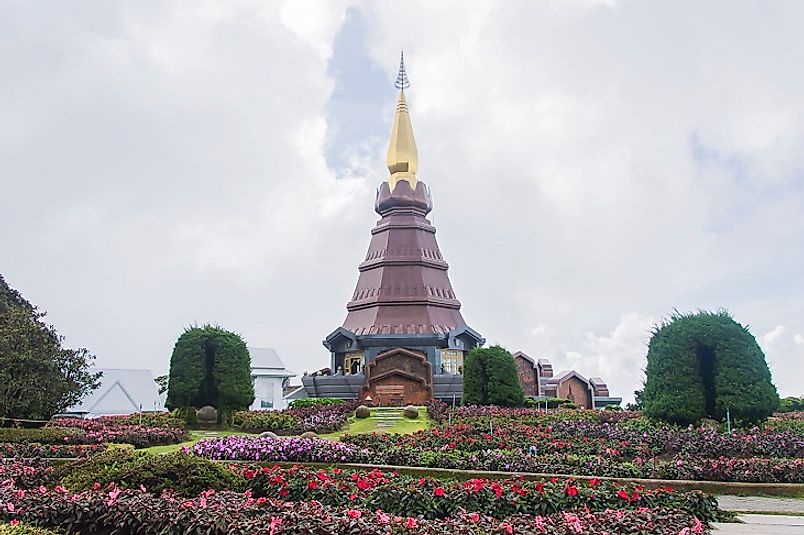Highest Mountains In Thailand

Thailand is a country in Southeastern Asia and borders four other countries, including Myanmar (Burma, Cambodia, Laos, and Malaysia. It also borders the Andaman Sea and the Gulf of Thailand. Mostly known for its scenic beaches, Thailand’s mountains are giving tourists more reasons to visit the country. Most of Thailand’s mountains ranges are situated in the North and Northeastern parts of the country. The country has a mean elevation of 287 meters and the highest point is on Doi inthanon with an elevation of 2,565 meters and the lowest point is on the gulf of Thailand with an elevation of 0 meters.
Doi Inthanon
Doi Inthanon is Thailand’s highest mountain, reaching up to an elevation of 2,565 meters. The mountain was previously known as Doi Luang, which means ‘Big Mountain’ in Thai. The mountain is home to scenic waterfalls in the lower and mid elevations such as the Mae Ya waterfall. The upper elevations of the mountain are characterized by a dense canopy of montane forests, dominated by oaks, tea-trees, and magnolias tree species. The dense canopy facilitates the growth of vegetation such as orchids, lichens, mosses, and ferns. The lower elevations are home to deciduous forests.
The entire mountain and surrounding areas, along with their flora and fauna, have been enclosed in the Doi Inthanon National Park. The mountain is home to over 400 bird species, including rare species native only to a few of Thailand’s mountains. Such birds include the green-tailed sunbird and the ashy-throated warbler. There are gorals, bears, and deer that roam the mountain alongside snakes and other small animals.
The Ping River and its tributaries originate from the mountain. The slopes of the mountain, being especially fertile, have been utilized for agricultural uses by the local communities. A tarmacked road was built by the military in the 1970s, which has made tourism activities easier and accessible on the mountain.
Doi Pha Hom Pok
The Doi Pha Hom Pok is the second highest mountain in Thailand at an elevation of 2,296 meters. The mountain is situated along the Burmese border in Chiang Mai and is enclosed in the Doi Pha Hom Pok National Park. Its name translates to ‘mountain covered by a blanket’, to refer to the thick forest visible in its higher elevations.
The dense forests surrounding the mountain facilitate a rich undergrowth of ferns, lichens, and mosses. Abundant species of orchids are found on the mountain as well. Mixed deciduous forests are found on the mountain together with dry dipterocarp forests at the lower elevations. There are mammals such as wild boar, macaques, gibbons and barking deer and over 300 bird species.
There are also numerous geysers and springs at the foot of the mountain, several of which are major tourist attractions. Waterfalls such as Tat Mok and Bhoo Muan are also attractions on the mountain. Tourism activities on the mountain are well coordinated in a bid to preserve the largely unaltered ecosystem.
Doi Chiang Dao
Doi Chiang Dao, at an elevation of 2,225 meters, is the third highest peak in Thailand. The mountain is part of the Daen Lao Range of the greater Shan Hills. Regarded to be 250 million years old, the limestone giant rises on the plains where Chiang Dao town is situated. The mountain is a renowned bird watching haven and has some rare species such as the Hume’s pheasant and Rusty-napped Pitta. The mountain is also home to rare flowers and butterflies.
The Chiang Dao National Park hosts the peak and manages all tourism activities in its territory. Various forests types exist in the mountain, which is also home to small numbers of an indigenous hill tribe. Flora and fauna in the mountain remain undisturbed.
Phu Soi Dao
Phu Soi Dao is the fifth highest peak in Thailand, having an elevation of 2,120 meters. The mountain is part of the Luang Prabang mountain range along the border with Laos. A 5-tier waterfall by the same name on the mountain is undoubtedly one of the main attractions on the peak. The mountain is characterized by virgin forests, mostly pine trees, and numerous rivers and streams. The peak is enclosed in the Phu Soi Dao National Park and supports abundant flower and bird life.
Impact on Tourism
Other high mountains in Thailand, and their respective elevations, include Khao Kacheu La at 2,152 meters, followed by Phu Khe (2,079 meters), Phu Lo (Doi Lo) (2,077 meters), Doi Mae Tho (Doi Lang Ka) at 2,031 meters, Doi Mae Ya (2,005 meters), and Doi Phong Sa Yan (2,004 meters). Thailand’s mountains have become increasingly popular tourist destinations due to their unique features. Efforts by the government to develop sustainable tourism infrastructure have facilitated this surge in tourism.
| Rank | Highest Mountain in Thailand | Elevation |
|---|---|---|
| 1 | Doi Inthanon (Doi Luang) | 2,565 meters |
| 2 | Doi Pha Hom Pok | 2,296 meters |
| 3 | Doi Chiang Dao | 2,225 meters |
| 4 | Khao Kacheu La | 2,152 meters |
| 5 | Phu Soi Dao | 2,120 meters |
| 6 | Phu Khe | 2,079 meters |
| 7 | Phu Lo (Doi Lo) | 2,077 meters |
| 8 | Doi Mae Tho (Doi Lang Ka) | 2,031 meters |
| 9 | Doi Mae Ya | 2,005 meters |
| 10 | Doi Phong Sa Yan | 2,004 meters |







